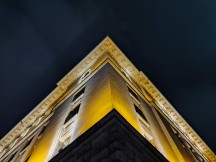OnePlus 8 review

A familiar setup minus the telephoto
Last year's disparity in the camera department between the OnePlus 7T and 7T Pro was barely noticeable and if it was just about the cameras, the 7T was the more sensible option of the both as it was cheaper. Unfortunately, that's not the case anymore. The OnePlus 8 swaps the telephoto lens for a dedicated macro one. And thus, the zoom photos are a simple 2x crop from the main 48MP sensor.

Which, by the way, gets a slightly narrower aperture than the OP 7T - f/1.8 down from the f/1.6. At least the OIS is still intact.
The ultra-wide camera gets a small bump up to 16MP but more importantly, has lost its autofocus capabilities. This called for a dedicated macro cam to be added - a 2MP fixed-focus one - for those close-up shots. The ultra-wide has f/2.2 aperture while the macro offers f/2.4.
The front-facing camera is the same 16MP sensor used before and paired with a lens having f/2.0 aperture.
Camera menus
There are some changes in the camera menu but they are mostly visual. Oh, and the Settings menu is no longer located in the modes drawer when you swipe up (or to the side depending on how you are holding the phone). You can enter the Settings menu quicker by just tapping on it in the upper-left corner of the viewfinder.





Camera menus, modes and settings
Also, if you, for some reason, want to shoot with the full 48MP of the main sensor, you can do so from the default Photo mode - there's a toggle and you don't have to switch to the Pro mode. Speaking of, it gives the full set of options - manual focus, white balance, ISO, exposure and shutter speed. You can also choose to shoot in 12MP, 48MP or in RAW.
Daylight samples
First off, since the main and ultra-wide cameras on the vanilla 8 are the same from the OnePlus 7 Pro and the 7T Pro, all three phones produce similar images. As expected, the OnePlus 8's processing is familiar.
During the day, the main camera captures good detail but sharpness, on the other hand, could be better. Colors are really punchy and vibrant, one could say they are a bit over the top. Dynamic range is impressive and white balance appears to be accurate. To our surprise, though, we found some noise in the sky and there's some fuzziness in some of the images. The sharpness drops and the noise goes a bit up when in indoor scenes even if they are well-lit.
Compared to the OnePlus 7 Pro, the 8 has more accurate white balance as the 7 Pro tends to go a bit on the warm side. The latter also manages noise during the day better and is closer to the real-life colors. In some really rare cases, the 7 Pro brings out more detail and is a bit sharper.
As expected, the crop zoom isn't nearly as good as the proper 2x telephoto. The images lack detail, they are soft, fuzzy and noisy. And if you are wondering how Samsung pulled it off when cropping from its 64MP sensor, well, the latter wasn't doing the pixel-binning thing. It was a pure 64MP sensor cropping from a much higher resolution, whereas in this case, the OnePlus 8 crops from an already binned 12MP image and then upscales back to 12MP.
The ultra-wide unit is also performing as expected - it produces softer images compared to the main cam and noise is higher but it retains the excellent dynamic range. Sharpening is a bit too much but it's not excessive and makes the images look generally better. We can even point out at images looking just as sharp as the main camera.









Daylight ultra-wide camera samples
Minor differences compared to the OnePlus 7 Pro ultra-wide camera as well.










Ultra-wide OnePlus 8 vs OnePlus 7 Pro
Low-light samples
The low-light samples aren't particularly impressive and there's no major improvement over the previous generation OnePlus phones. You can see plenty of noise if you look closely enough, detail is lacking and sharpness could be better. But the contrast, dynamic range and colors look really nice.








Low-light samples in Photo mode
And even though we don't recommend Night modes all that often, in this case, it's very good. The Night mode crushes the noise, brings out even more detail out of the shadows and highlights, adds just the right amount of sharpness and the best part is that it stacks the images really fast. This is probably the fastest Night mode we've tested and it feels almost as if you are shooting in the normal Photo mode.








Low-light samples in Night mode
So, is there any improvement over the previous generation in the low-light? Well, in the default Photo mode, both phones perform almost identically except for the white balance. This time around, the 7 Pro tends to cooler in some of the scenes while the actual light source emits warm light. Other differences, all of which hard to notice, include brighter images with a bit more detail from the 7 Pro, higher contrast from the 8, and the noise reduction algorithm is considerably more aggressive with the 7 Pro. With the exception of the sky, where the 8 offers clearer view. And there's virtually no difference with the Night mode, the 7 Pro is warmer and generally brighter, but that's it.














Low-light OnePlus 8 vs OnePlus 7 Pro














Night mode OnePlus 8 vs OnePlus 7 Pro
The ultra-wide camera, like most out there, isn't impressive in the dark and produces rather soft, noisy and some of the photos look like they are out of focus. Contrast, dynamic range and colors look just as good as on the main camera.
The good news is that you can use the Night mode to save pretty much all of your nighttime shots. The Night mode adds the much-needed sharpness, reduces the noise and brings out more detail from the highlights and shadows for the photos by the ultra-wide.
No difference in the ultra-wide images too, except color temperature again. The 7 Pro is a bit more accurate in this regard.










Ultra-wide Night mode OnePlus 8 vs OnePlus 7 Pro
You can also take a look at our photo compare tool and see how it stands against some of its rivals.



OnePlus 8 vs OnePlus 7T Pro and the Samsung Galaxy S20+ in our Photo compare tool
Macro samples
Due to the fixed-focus properties of the dedicated macro cam, it's often hard to capture your miniature subjects in focus, especially if there is wind. The detail isn't impressive as well - it's a 2MP sensor anyway. And you absolutely need lots of light to get a proper macro. Honestly, this cheap sensor isn't nowhere near the excellent macro capabilities the ultra-wide camera from last year demonstrated.
Portraits
In portrait mode, the main camera seems to quite consistent when changing lighting conditions and backgrounds. It delivers good amount of detail, the images look generally sharp, colors pop while retaining pretty natural and accurate skin tone. The faux bokeh effect seems pretty well-executed as well. Sure, there are some glitchy separations if you look close enough but the software is still doing a pretty good job even with more complex backgrounds.
You can also do 2x zoom portraits but we wouldn't recommend doing that as you will lose a good amount of detail and sharpness by doing so and portraits come out a bit over-saturated.
Seflies
The selfie camera can do sharp, colorful pictures rich in detail. The dynamic range is also quite impressive no matter if you use portrait mode or not. Which, by the way looks just as good as the portrait mode with the main camera. The edge detection is surprisingly accurate.






Selfie samples: Normal • Portrait
Video recording
Unlike the most 2020 flagships so far, the OnePlus 8 can't shoot 8K videos and to be honest, we don't really want it to. At least for now, we'd prefer good 4K and Full HD videos. It can do both in 30 and 60 frames per second while the slow-motion videos can go up to 240fps in 1080p or 480fps in 720p. There's also this Super Stable video mode that caps at 1080p but gives you gimbal-like stabilization by doing extreme cropping around the edges. A new cinematic mode has also been introduced recording in 21:9 aspect ratio.
The 4K video looks nice, color-wise, and offers wide dynamic range, good contrast and no noise. However, we don't find it sharp enough for a 2160p footage.
The 1080p video is identical in terms of processing but naturally is even less sharp than the 4K one.
You can record 2x zoom videos by cropping from the main sensor but as expected, the quality is underwhelming.
The ultra-wide camera can do some pretty nice footage in 1080p and 2160p. We found it to be pretty similar in terms of quality compared to the main sensor although a bit on the softer side. But this doesn't come as a surprise either.
The 21:9 cinematic video can be taken with either the main sensor or the ultra-wide one. We recommend sticking to the first one and you only stand to gain the wider field of view and cinematic aspect ratio if you find it more pleasing.
We also did a comparison between the normal stabilized 4K video and the Super Steady mode in 4K. We found that the Super Steady mode shoots using the ultra-wide lens as it has more headroom to crop around the center and it's also an upgrade in resolution. The older generation OnePlus phones, which supported this feature, were capped at 1080p. The stabilization itself seems pretty good but it also seems that the normal 4K mode has also been largely improved upon.
You can also take a look at our video compare tool and see how it stands against some of its rivals.



4K: OnePlus 8 vs OnePlus 7T Pro and the Samsung Galaxy S20+ in our Video compare tool
Camera verdict
There are no major improvements with the cameras compared to last year's OnePlus 7T and we felt that OnePlus should have continued to improve upon this camera setup. So we can't strip away the feeling the camera on this phone is a downgrade in comparison. The switch from a proper telephoto lens to a macro unit is a big disappointment because the 7T did both better. The zoom was optical and the macro was handled by the higher resolution ultra-wide camera, which had autofocus. Macro shots were pretty nice. And so were the zoom photos. Not to mention that the OP 8 comes at an even higher price than the 7 Pro and 7T Pro (accounting for the storage) when they launched.
Reader comments
- Muhammad Haroon
- 06 Apr 2025
- 6Qx
Please my Mobile updates one plus 8
- asiaferrari
- 03 Apr 2024
- nhM
I would like a new OnePlus based on the same size of Op8 . Now are too bigger
- Anonymous
- 20 Apr 2023
- Iwc
I have been using a OnePlus 8 for well over a year now and the battery lasts at least a day but sometimes 2. I use my phone about 3 hours a day for games like clash of clans or fallout shelter, watching YouTube, and using Snapchat, and searching the ...
































































